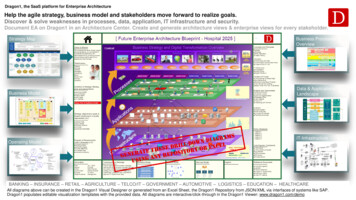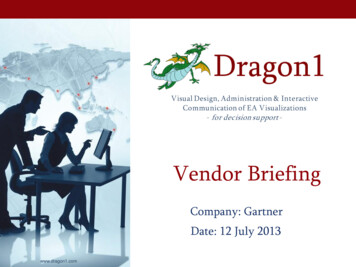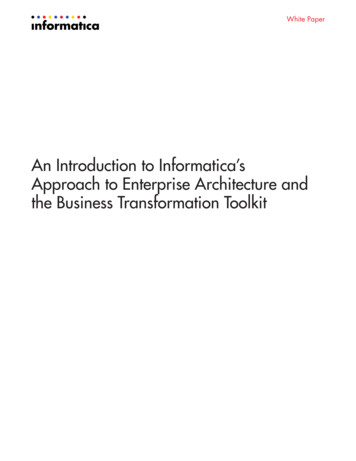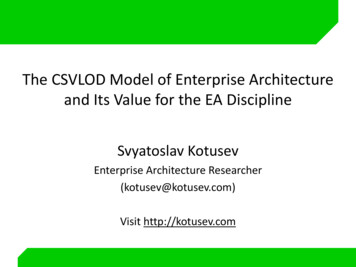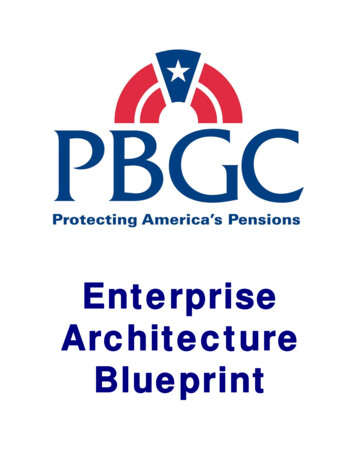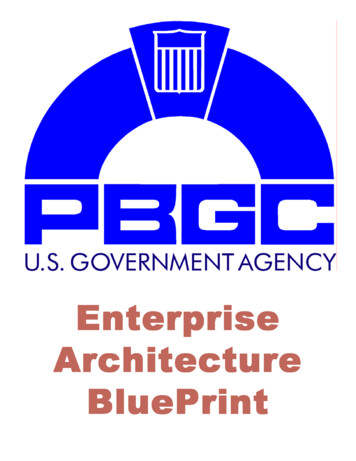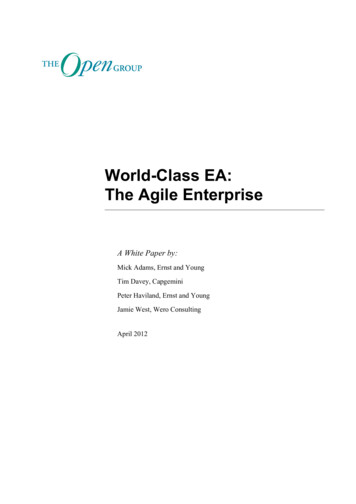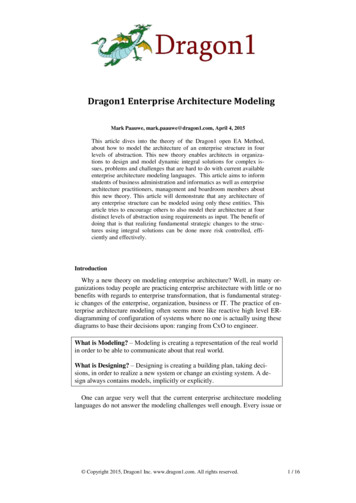
Transcription
Dragon1 Enterprise Architecture ModelingMark Paauwe, mark.paauwe@dragon1.com, April 4, 2015This article dives into the theory of the Dragon1 open EA Method,about how to model the architecture of an enterprise structure in fourlevels of abstraction. This new theory enables architects in organizations to design and model dynamic integral solutions for complex issues, problems and challenges that are hard to do with current availableenterprise architecture modeling languages. This article aims to informstudents of business administration and informatics as well as enterprisearchitecture practitioners, management and boardroom members aboutthis new theory. This article will demonstrate that any architecture ofany enterprise structure can be modeled using only these entities. Thisarticle tries to encourage others to also model their architecture at fourdistinct levels of abstraction using requirements as input. The benefit ofdoing that is that realizing fundamental strategic changes to the structures using integral solutions can be done more risk controlled, efficiently and effectively.IntroductionWhy a new theory on modeling enterprise architecture? Well, in many organizations today people are practicing enterprise architecture with little or nobenefits with regards to enterprise transformation, that is fundamental strategic changes of the enterprise, organization, business or IT. The practice of enterprise architecture modeling often seems more like reactive high level ERdiagramming of configuration of systems where no one is actually using thesediagrams to base their decisions upon: ranging from CxO to engineer.What is Modeling? – Modeling is creating a representation of the real worldin order to be able to communicate about that real world.What is Designing? – Designing is creating a building plan, taking decisions, in order to realize a new system or change an existing system. A design always contains models, implicitly or explicitly.One can argue very well that the current enterprise architecture modelinglanguages do not answer the modeling challenges well enough. Every issue or Copyright 2015, Dragon1 Inc. www.dragon1.com. All rights reserved.1 / 16
problem you want to solve with architecture modeling requires you to extendthe architecture modeling language used with extra rules, core concepts andun proven theory. That shows the languages are not fit for the job anymore.Common issues and problems in enterprise architecture we try solve by modeling but are not succeeding is:1. It is very hard, when using the current modeling languages, tomodel the difference between implementation dependent and implement independent situations.2. How to model and analyze complex changing business processesand information systems like legislative systems with multiple regimes per legislation?3. How to model standards, rules and principles (way of working) aseffective guiding boundaries for other (sub)models modeled byothers in a multi modeling team and multilevel architecture (reference architecture, domain architecture and solution architecture)environment?4. How to model the unknown or postpone/delay detailing or finalizing the type of entity in a later stadium?5. Modeling what-if scenario‟s with assumptions, input and outputvalues and business outcomes?6. Modeling across business(function) domain and industry specificborders: a model that works both within government and commercial organizations or both within chemical industries and retail industries?7. Modeling that is linked to building information modeling (buildingarchitecture)?This obviously means that the Dragon1 Architecture Modeling language isonly able to answer to design issues and modeling problems it was designedfor to solve. Because of that the meta model will surely undergo changes thecoming years to incorporate new constructs and entities. But not on everypractice it is used for.What is a Modeling Language? – A Modeling Language is a rule-basedartifical language to express information, knowledge or system structures andcan be graphical and/or textual.Most modeling languages within enterprise architecture do not go beyond apoint where you cannot model it in PowerPoint or Visio. The number of symbols is a limited number and specific attributes, other than the name and adifferent color, line style or size for a symbol is not present. With these kind Copyright 2015, Dragon1 Inc. www.dragon1.com. All rights reserved.2 / 16
of limitation modeling language discharge themselves from being capable ofsupporting real design challenges.Here follow 10 cases of fundamental strategic changes the Dragon1 Architecture Modeling Languages has to be able to answer:1. An multinational enterprise consisting of several stove pipe organized businesses in several countries need to standardize, rationalize and integrate on the information systems and IT infrastructurelevel so the company can collaborate more and (re)use informationmore efficient2. An organization wants to drastically shorten the time-to-market forintroducing a new product line and service line3. Three completely companies or municipalities want to integrateand work with their own shared service center (operations stay decentralized), governance of the new organization must be centralized. It must be a federated model.4. A company wants to outsource the IT operations and it has to beless complex and less costly and have a higher continuity after it isoutsourced.5. A companies wants to introduce new technology in all of theirproducts6. A healthcare company wants to innovate using Robotics, VirtualReality and 3d printing. Architecture should help to redesign thebusiness model and create situational companies.7. A telecom company want to standardize their delivery systems intoone configurable systems. And also security issue for online services and client self service dossier have to be solved using architecture.8. The company has a gigantic gaps between business capabilities andhuman competence. Architecture should be used to fix it.9. Governance, Programs and Projects are failing and architecture hasto solve this10. IT and business process are to complex. To many databases andapplications are present, Single Sour of truth is not implemented.Architecture has to solve this.As denominator, all the Fortune 500 companies and government institutions should be able to model their enterprise architecture in a detailed wayusing Dragon1. If that is the case, the modeling language is developed sufficiently.As an example some companies of the Fortune 500 are listed below just togive you an idea of what should and could be modeled. Copyright 2015, Dragon1 Inc. www.dragon1.com. All rights reserved.3 / 16
1.2.3.4.5.6.7.8.9.10.11.12.13.14.15.16.17.Wal-Mart storesExxon MobilChevronBerkshire HathawayAppleGoogleMicrosoftGeneral MotorsGeneral ElectricSamsungIBMShellSonyEasyJetToyotaWalt DisneyNATOAll these companies should be able to redesign or analyze their current enterprise architecture and design their to-be architecture in detailed (governance, business, information and technology) way completely using Dragon1enterprise architecture modeling language. With the modeling language theyshould be able to express all the knowledge, informative and system structuresthey posses or have.Overview of current (enterprise architecture) meta models and erprise/Business Motivation Model-Building Information Model Copyright 2015, Dragon1 Inc. www.dragon1.com. All rights reserved.4 / 16
-Event Process ChangeWhere does the new theory comes from?In building architecture, construction and engineering we have many building structures that where build using architecture and there are also many,many architecture books documenting the knowledge used to design the architecture and build the structure using the architecture.When reading those books one can re-engineer a meta model from the textwith which we could (re)design, (re)model and (re)build the structure orintegral solutions for the structure.This meta model holds not only other entities but also other definitions forknown entities. For instance architecture is now a special total concept andprinciple is about the way things work. These are very big changes whenlooking at current architecture modeling languages.Import to note is that in many countries where English is not the native language people are trying to create modeling languages in English. With allrespect to everyone, this still leads to a lot of problems.The Dragon1 Core Meta Model for Architecture Modeling can be used there-engineer the architecture of the Colosseum in Rome, The old opera in Paris, the Eiffel Tower, The Millau Bridge, The Notre Dame Church, The 360Airbus, The Pyramid of Toetanchamon and the Temple of Heaven (China),The Google Organization, Sony, Toyota and Coca Cola. Also the name of thestructure differs from the name of the total concept. For example, the Colosseumis an half open elliptic Amphitheatre.What is (enterprise) architecture for?Architecture is a special total concept, with coherent operative, constructiveand decorative concepts, applied onto a structure. Analogue to this EnterpriseArchitecture is a special total concept for an enterprise structure.What is Enterprise Architecture? – Enterprise Architecture as field ofstudy is the art and science of designing and realizing enterprise structures.Enterprise Architecture as the architecture of an enterprise structure, is the isa special total concept of an enterprise structure. An enterprise architecture isa coherent set of operative, constructive and decorative governance, business,information and technology concepts.If one designs and realizes an (enterprise) structure without designing a total concept first more often the construction, operations and decorations willnot fit the requirements of the owner-client and stakeholders as much as poss- Copyright 2015, Dragon1 Inc. www.dragon1.com. All rights reserved.5 / 16
ible. With architecture (the total concept) the designer (i.e. architect) will useintegral solutions and future proof solution for problems that are moreintegral, centrally, standardized and rationalized. The design and realized (enterprise) structure will have more coherence in construction itself. It will bestronger than otherwise. The operations will better fit the (enterprise) structureand later (currently unknown, unthoughtful or unforeseen) usage by user. Theconstruction will support execution of operations better and usage of facilitiesand infrastructures in or at the spaces on or at the location where the structureremains.The most important reason for architects to call what they are doing not justplain „design‟ but architecture, is that they do conceptual modeling in order todesign a solution answering to conflicting or contradictory requirements ofstakeholders. If you do conceptual modeling you postpone or evade all kindsof implementation issues. Suppose one stakeholder wants to have a secureworkplace as a solution and another stakeholder wants to have a mobileworkplace as a solution, than you as architect have the challenge to design asecure mobile workplace. The thing you do as architect is to find and selectsecure mobile concepts and mobile secure concepts for workplace known inthe industry, but you also look at other sciences and in the industry at otherareas how they have combined secure and mobile concepts in one solution.Architects get their inspiration from nature what concepts and phenomenathere are and how they work and produce results (the concepts principle).What is an Enterprise Architect? – An enterprise architecture is a designerof special total concepts for enterprise structures. An enterprise architectcreates a coherent set of operative, constructive and decorative governance,business, information and technology concepts, answering to the stakeholders requirements with regards to an enterprise structure.Architects, at least on paper, can give people wings and make them fly ordesign a house that does not need fossil based energy anymore, and they canrefine their design and in the end maybe have a workable solution. Whenmodeling at a conceptual level it is easy to project or borrow concepts fromone area to another. This is why architects do conceptual modeling and this iswhy total concept design by architects is and can be called architecture.Architecture is about increasing the quality of the design and the quality ofthe realization of a structure. So the architecture (i.e. total concept) containsconcepts on how to create a good design (like a concept as RequirementsAnalyses) but also contains concepts to realize a structure or integral solutionfor the structure in the correct way (like a concept as Work from Inside Out,or from bottom to top – First you create the systems/foundation layer, then theservices layer on top of that, etc ). Copyright 2015, Dragon1 Inc. www.dragon1.com. All rights reserved.6 / 16
Although it has the overhand nowadays, architecture is and was not meantto be labeled on activities that deal with the design of a complex system withfocus on a certain operation, like an information systems that can process anykind of legislation on any set of citizen tax data. If the design contains no constructive and/or decorative concepts, the design is NOT architecture, it is not aspecial Total Concept.Below follows an example architecture diagram showing the concepts viewof an enterprise structure. The name of the total concept is “Robotic HealthCare Service Delivery” You see an enterprise with three businesses and theirbusiness functions and a framework with sub architectures and in it constructional, decorative and operational concepts. And per concept that needs to beimplemented the main function. And per concept the core three elements itholds and per concept the principle of the concept and the results of the principle linked to requirements and goals of the enterprise.The first steps an Enterprise Architect always takesThe first steps an enterprise architect always takes whatever the design assignment is, is he models the existing and known elements and functions ofthe enterprise structure and he models the needs and issues of the owner/clientand stakeholder (with focus on users) with regards to that enterprise structure.Next he helps the stakeholder to utter performance and quality requirementsfor the functions and elements of the enterprise structure. Also for that hecreates a model.Now the action really starts when the enterprise architect begins thinking,looking and selecting concepts to answer the conflicting and contradictoryrequirements for the functions and elements of the enterprise structure. I sayaction, because he goes out there to look for concepts. A real architect doesnot still and googles and checks documents. A real architect visits sites, talkswith people, experiments. And uses all experience from that to select, projectand combine concepts from anywhere and everywhere for his total concept,his architecture for the enterprise structure.The enterprise architect always creates various versions of a design sketchof a total concept and communicates that to the owner/client and discusses it,to have the owner/client decide for a version. It is this work that makes andenterprise architect and enterprise architect, as opposed to being a consultant,advisor, analyst, designer, director or project manager.If there is already an existing enterprise structure, the enterprise architectwill try establish the identity of the enterprise structure (what it is and what ittries to be, because these two might me different and an identity crisis mightbe the case). It matters a great deal if a company for instance is a bank selling Copyright 2015, Dragon1 Inc. www.dragon1.com. All rights reserved.7 / 16
insurance products, or if a company is a supermarket, selling insurance products. Solving the same issues will require different solutions, because alonethe context is completely different.How can we break breakdown structure of a modeling language?A modeling language is defined as:Five parts (element) make up an architecture modeling language (as concept). The specification of the modeling language with hold these:1. A list of named and defined entity classes2. Shapes for the named entities3. Meta model (the relationships between entity classes)4. A CRUD / cross-reference matrix showing mandatory and optionalrelationship or connections between entities.5. A list that details by example the issues and challenges the language was created for to solve. The details contain reference andexample user models created using the meta model dealing withcertain issues, challenges.A description of the meta modelThe Dragon1 meta model consist of a core with 25 entities and around thattwo four rings: The core is called The Structure, Ring 1 is called The Design,Ring two is called The Realization, Ring Four is called Science, Ring is calledArt. This division is based on the old definition of Architecture being the art(5) & science (4) of design (2) and realization (3) of structure (1). Art andScience are extended with new concepts every day, so the art and science domain only contain the basic concepts in the Dragon1 User Models. The Design and Realization domains contain also the basic concepts. And also designand realization as science do not change that often at the moment, the basicconcepts of a structure hardly change or have changed. Architecture is aboutbuilding on solid foundation, so the meta model of Dragon1 also must use thatwisdom.The structure in Dragon1 can be anything having the three dimensions ofconstruction, operation and decoration, like a church, building, house, bridge,airplane, traffic junction, bakery, human body, tree, tree house, enterprise,organization, information system and business process.The Design domains can also be called the Analyses and Design domain.The realization domain can also be called the Realization and Maintenancedomain. One could recognize a Governance and Management Domain abovethe structure and a Operations and Usage domain below the structure. We donot do that in this article. Copyright 2015, Dragon1 Inc. www.dragon1.com. All rights reserved.8 / 16
For every entities we can argue why it is been made part of the model. Ofcourse many other entities could also have been made part of the meta model,but practice shows that this is the minimal set that must be used in order to beable to re-engineer and document the architecture of a structure.The reason that form is part of the meta model if because of that famousarchitect claim that it is a good practice in architecture that form follows function. Also the reason that problem is in the meta model is because of the solution that has to be designed as answer to the problem (that is the question).Unknown and assumption are present in the model because an architect doesnot get all answers to all questions fired off to the stakeholders.The 13are:1.2.3.4.5.6.7.8.9.10.11.12.13.common and generic architectures that are created using Dragon1Reference ArchitectureChain ArchitectureEnterprise ArchitectureGovernance ArchitectureBusiness ArchitectureOrganization ArchitectureInformation ArchitectureTechnical Architecture/Technology Architecture / IT InfrastructureSecurity ArchitectureApplication ArchitectureData ArchitectureHuman Capital ArchitectureSolution ArchitecturePer architecture global, medium and detailed models are created of concepts, elements, components and technical products (the four layers of abstraction. For instance the business model may exist of up to 5 or 10 sub models.Next per concept or element architecture are created like: Process Architecture, Service Architecture etc Copyright 2015, Dragon1 Inc. www.dragon1.com. All rights reserved.9 / 16
Dragon1 Core Meta Model Entities DomainsArtDesignThe structureRealizationScienceThe 100 core entities in the meta model of Dragon1 are the 7.18.19.20.UnknownSystemEntityEntity ClassEntity TypeEntity SortEntity otal bjectTechnical ProductMeta Model Copyright 2015, Dragon1 Inc. www.dragon1.com. All rights reserved.10 / 16
4.55.56.57.58.59.60.61.62.63.User ModelInstance ModelRuleGuidelineDesignRealization(architecture decision) eholderNeedRequirementFragmentBuilding ContractorEngineerFunctionAnnotation lineCapabilityAbilityDisability(technical) ario Copyright 2015, Dragon1 Inc. www.dragon1.com. All rights reserved.11 / 16
atusOwnershipInformationData Copyright 2015, Dragon1 Inc. www.dragon1.com. All rights reserved.12 / 16
Next to these architecture concepts, dragon1 also defines 400 generic enterprise/business elements like product, service, process, onto computer, machine, technology, material and robot. These are concepts themselves but often in the context of Enterprise Architecture elements of the concepts andconcept principles we define. And also dragon1 defines 100 generic enterprisearchitecture concepts like: Process Orientation, Customer Centric Approach,Leadership, Knowledge, Sales and Marketing. In fact all of the known business functions are global generic concepts. And today in enterprise architecture we look for specialized detailed concepts like eBusiness, eProcurement,robotized service delivery, etc.We know that in time new concepts, elements, components and technicalproducts will arise new requirements will appear and technology will be invented. What stays is that enterprises, businesses, organizations and companies have to deliver products and services to humans and other organizationsand fulfill their changes needs by being adaptive or reinvent/redesign themselves. And that is what Dragon1 Enterprise Architecture Modeling Languages is focused on supporting and enabling.Main concepts in Dragon1 are: Work(ing), Collaboration, Production, Living, Procurement/Buying, Sales/Selling, Research, Procurement, Marketing(product Launch), Logistics, Finance (Bookkeeping), HRM. All the basicelements and components part of Dragon1 arise from these concepts. Withthat a generic 4 layered architecture reference model for enterprise can becreated. If a new concepts is thought of or invented, the constructs in the language like entity class, attribute etc., can be used to create and add the newconcepts, its elements, objects, components and technical products to the metamodel and then create user models with it.Parts of Dragon1 are not only Business Concept and Information Concept,etc. but the elements in the core met model come from Analysis and DesignConcepts and Realization or Engineering Concepts. Normally Principles ofDesign and Project Management Principles are part of Dragon1.Creating User Models using the meta modelOrganization have their products, services, processes, activities and applications. They have their customers, clients, contract, employees, computers,robots, process oriented approach, 360 degree customer view, big data, nanotechnology, smartphone, iPad, cross selling, up selling, MS Word, GoogleBrowser, 3d printer, Amazon Cloud etc. All these things can be viewed asconcepts, elements, components and technical products. At user model levelorganizations define their concepts, elements, objects, component and tech- Copyright 2015, Dragon1 Inc. www.dragon1.com. All rights reserved.13 / 16
nical products. Often using reference models for that or best practices. Important to note is that you can (and in the future will) design organizations without services, processes, employees. So these concepts or elements might better not be part of the meta model of your modeling language.Dragon1 has a set of 100 concepts, patterns and principles (market & client,governance, business, information/application/data, it infrastructure / technology and security concepts) and about 1000 generic elements, components andobjects that are enterprise or organization generic. But these concepts, ele-ments and components should notHow to do architecture modeling using the meta modelWith this meta model one can design architecture. With architecture onecan bridge the gap from strategy to business change and in fact enable business changes.If in an organization the strategy requires is a series of business changesrealized through business and IT projects, it a good practice to design or model the AS-IS and TO-BE enterprise architecture and for the strategy to designa solution architecture. With these architecture the projects will have a designof a total concept. The core meta model contains that much project and realization related entities because if at execution of the project it is unclear howthe architecture should be used or have impact, you might as well have notcreated the architecture at all.[here is the dragon1 version of the ArchiMate meta model or business motivation model]Extending the meta modelIf you are in an certain industry or market you may find in a certain modeling situation that the Dragon1 core meta model is missing a certain construct,or that at user model level you are missing a certain industry specific concept,element, object or component. For instance Care Path within Health Careor Grade within Education. You are then enabled with the ability to extendthe core model with your concept, element, object, component or other construct. Copyright 2015, Dragon1 Inc. www.dragon1.com. All rights reserved.14 / 16
Projection of Concepts and Principles onto landscapes and blueprintOf every concept a principle detail diagram can be created. The theoreticgeneric version or your organization specific version can be created. But nextit should be projected onto the organizations current and future situation. Inthat way you how wel it is already implemented or what needs to be done still.Below is an example principle detail diagram of a concept and an exampleprojection of it on a landscape.Enterprise Architecture Design in four stagesDragon1 defines an enterprise architecture design in four stages: ConceptArchitecture Design, Preliminary Architecture Design, DefinitiveArchitecture Design, Detailed Architecture Design. In every stag thearchitect proposes concepts, elements, components and technicalproducts as answer to requirements from the owner-client andstakeholders. The owner client every stage decides to choose whatvision or version of the design and proposals, design decisions he goesalong with. The owner client may install a steering committeemandated with that authority to take architecture design decisions.Example Visualizations of View of ModelsBelow we give an enterprise model in four different levels of abstractionand one composed/integration model with all levels of abstraction in one. Theconceptual model is diagrammed and sketched (with metaphorical symbols)as a design sketch of a total concept, the logical model is diagrammed but alsodrawn, the physical model is diagrammed and the implementation model isdiagrammed and also pictured as an example Artist Impression (A management Overview). All of these visualizations of views of model where createusing this meta model carefully.Further StudyEnterprises and organizations are, just like churches, castle and bridge notstatic system structures. They are dynamic. The change (decay), interact withtheir environment.It would be good to see if on universities around students would try to document the architecture of structure in order to test, evaluate and enable us torefine the Dragon1 meta model. Also in organizations we encourage to re- Copyright 2015, Dragon1 Inc. www.dragon1.com. All rights reserved.15 / 16
engineer and document the AS-IS enterprise architecture of the organizationand the TO-BE solution architecture in any project. This will make peopledocument the knowledge of the organization on various topics and also willlead to knowledge and additions to the Dragon1 Wiki that is built around themeta model.Outside of the field of enterprise architecture in many other sciences, liketraffic and medicine, the meta model can be tested for added value to reformulate and visualize for instance the architecture principles and make them moreeffective.In business administration and information science the text books can beimproved by writing down the principles of concepts more in terms of theDragon1 Meta model.LiteratureDragon1 open EA Method Wiki. http://wiki.dragon1.org – Specification ofthe Dragon1 Enterprise Architecture Modeling Language. Copyright 2015, Dragon1 Inc. www.dragon1.com. All rights reserved.16 / 16
tecture and build the structure using the architecture. When reading those books one can re-engineer a meta model from the text with which we could (re)design, (re)model and (re)build the structure or . Enterprise Architecture as the architecture of an enterprise structure, is the is a special total concept of an enterprise structure. An .
